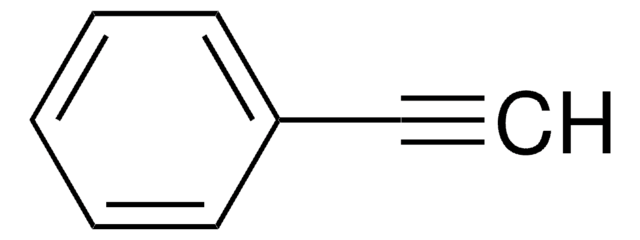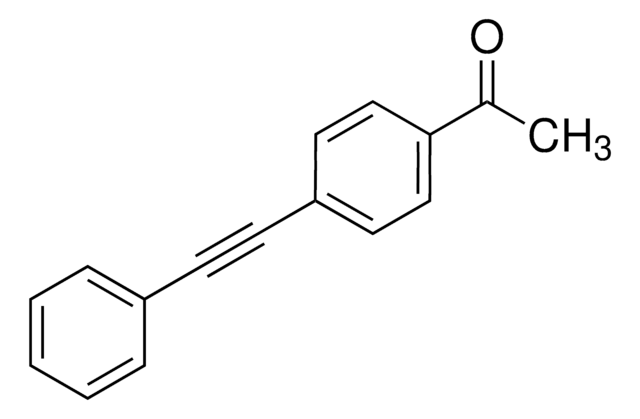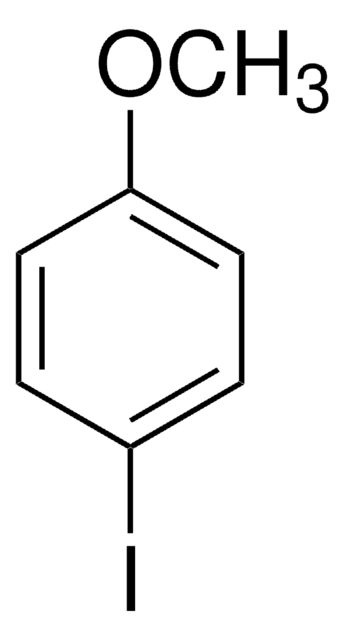All Photos(1)
About This Item
Linear Formula:
ClC6H4C≡CC6H5
CAS Number:
Molecular Weight:
212.67
MDL number:
UNSPSC Code:
12352100
PubChem Substance ID:
NACRES:
NA.22
Recommended Products
Assay
98%
mp
81-83 °C (lit.)
functional group
chloro
phenyl
SMILES string
Clc1ccc(cc1)C#Cc2ccccc2
InChI
1S/C14H9Cl/c15-14-10-8-13(9-11-14)7-6-12-4-2-1-3-5-12/h1-5,8-11H
InChI key
YMZAAGCDWVIPNL-UHFFFAOYSA-N
Related Categories
General description
1-Chloro-4-(phenylethynyl)benzene is an internal alkyne that can be prepared by palladium-catalyzed Kumada cross-coupling reaction.
Application
1-Chloro-4-(phenylethynyl)benzene may be used in the preparation of 1-(4-chlorophenyl)-4-methyl-2-phenylnaphthalene and 2-(4-chlorophenyl)-4-methyl-1-phenylnaphthalene as a 1:1 mixture.
Signal Word
Warning
Hazard Statements
Precautionary Statements
Hazard Classifications
Eye Irrit. 2 - Skin Irrit. 2 - STOT SE 3
Target Organs
Respiratory system
Storage Class Code
11 - Combustible Solids
WGK
WGK 3
Flash Point(F)
Not applicable
Flash Point(C)
Not applicable
Personal Protective Equipment
dust mask type N95 (US), Eyeshields, Gloves
Choose from one of the most recent versions:
Certificates of Analysis (COA)
Lot/Batch Number
Don't see the Right Version?
If you require a particular version, you can look up a specific certificate by the Lot or Batch number.
Already Own This Product?
Find documentation for the products that you have recently purchased in the Document Library.
Synthesis of Internal Alkynes by Pd(PPh3)4/TMEDA-Catalyzed Kumada Cross-Coupling of Alkynyl Halides with Grignard Reagents.
Zhang MM, et al.
European Journal of Organic Chemistry, 2014(30), 6769-6773 (2014)
Practical synthesis of polysubstituted naphthalene derivatives via HNTf2-catalyzed benzannulation reaction.
Ponra S, et al.
ARKIVOC (Gainesville, FL, United States), 2, 62-81 (2016)
Alisa Bahar Beydogan et al.
The Journal of pharmacy and pharmacology, 71(3), 408-416 (2018-11-15)
A large amount of fructose is metabolized in the liver and causes hepatic functional damage. Δ9 -tetrahydrocannabinol (THC) is known as a therapeutic agent for clinical and experimental applications. The study aims to investigate the effects of THC treatment on
Our team of scientists has experience in all areas of research including Life Science, Material Science, Chemical Synthesis, Chromatography, Analytical and many others.
Contact Technical Service
![4-[(4-Fluorophenyl)ethynyl]phenol AldrichCPR](/deepweb/assets/sigmaaldrich/product/structures/188/684/0b16c024-0d26-4b43-a607-60b40446e593/640/0b16c024-0d26-4b43-a607-60b40446e593.png)
![1-METHOXY-4-[(4-METHOXYPHENYL)ETHYNYL]BENZENE AldrichCPR](/deepweb/assets/sigmaaldrich/product/structures/912/576/242910ee-f375-45ae-b9ac-d2665ddc7171/640/242910ee-f375-45ae-b9ac-d2665ddc7171.png)







